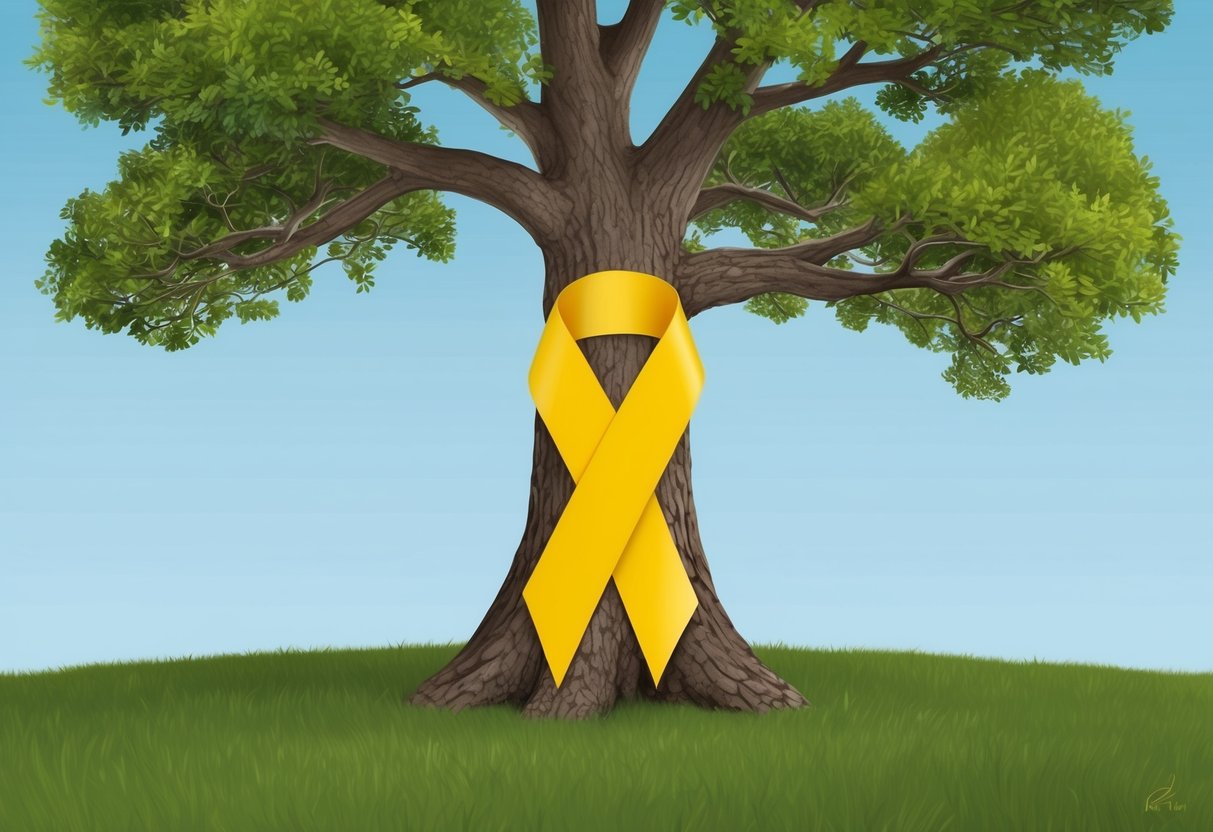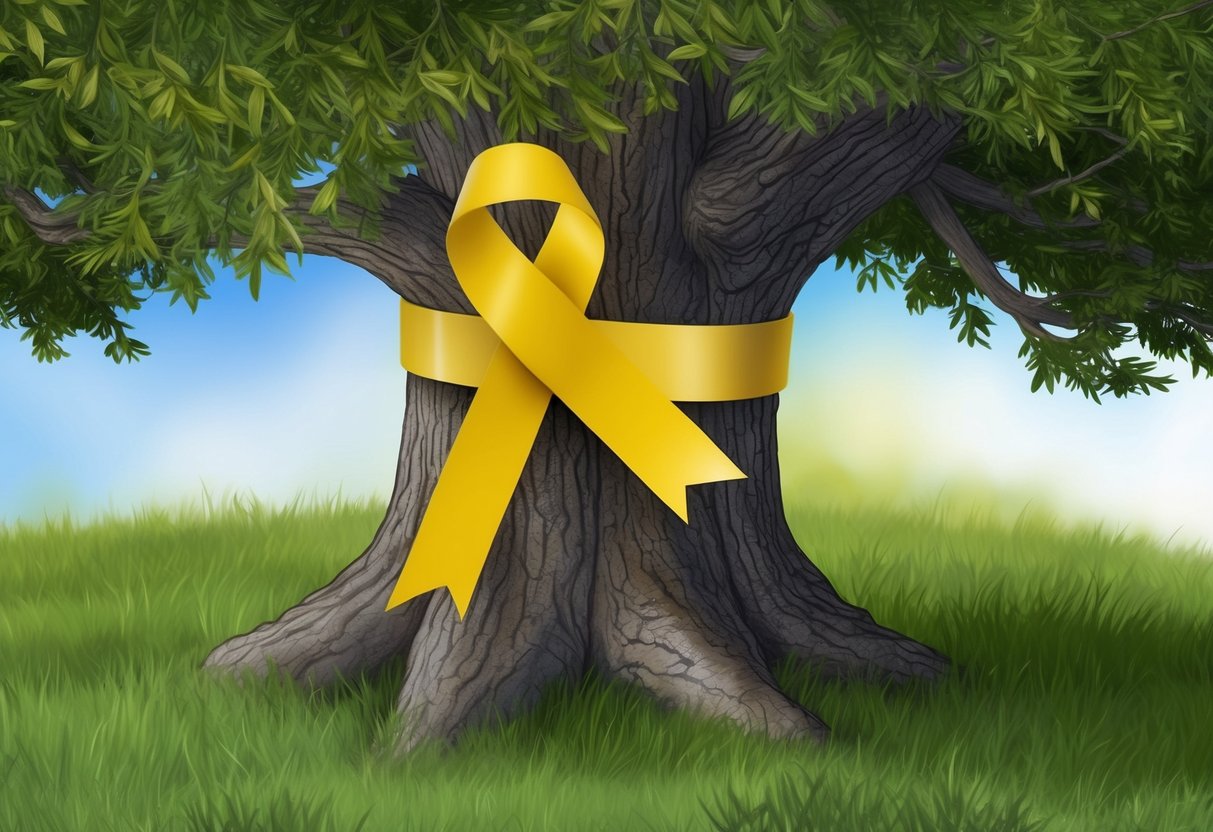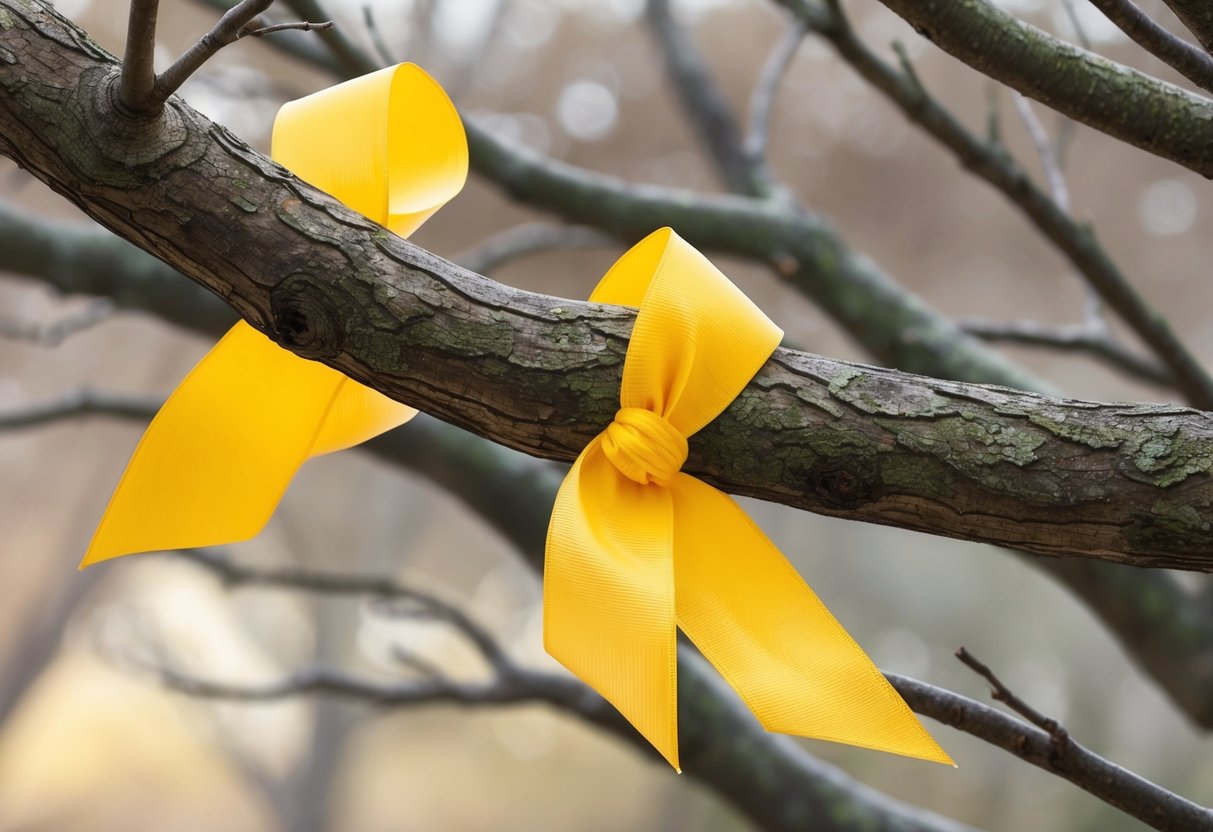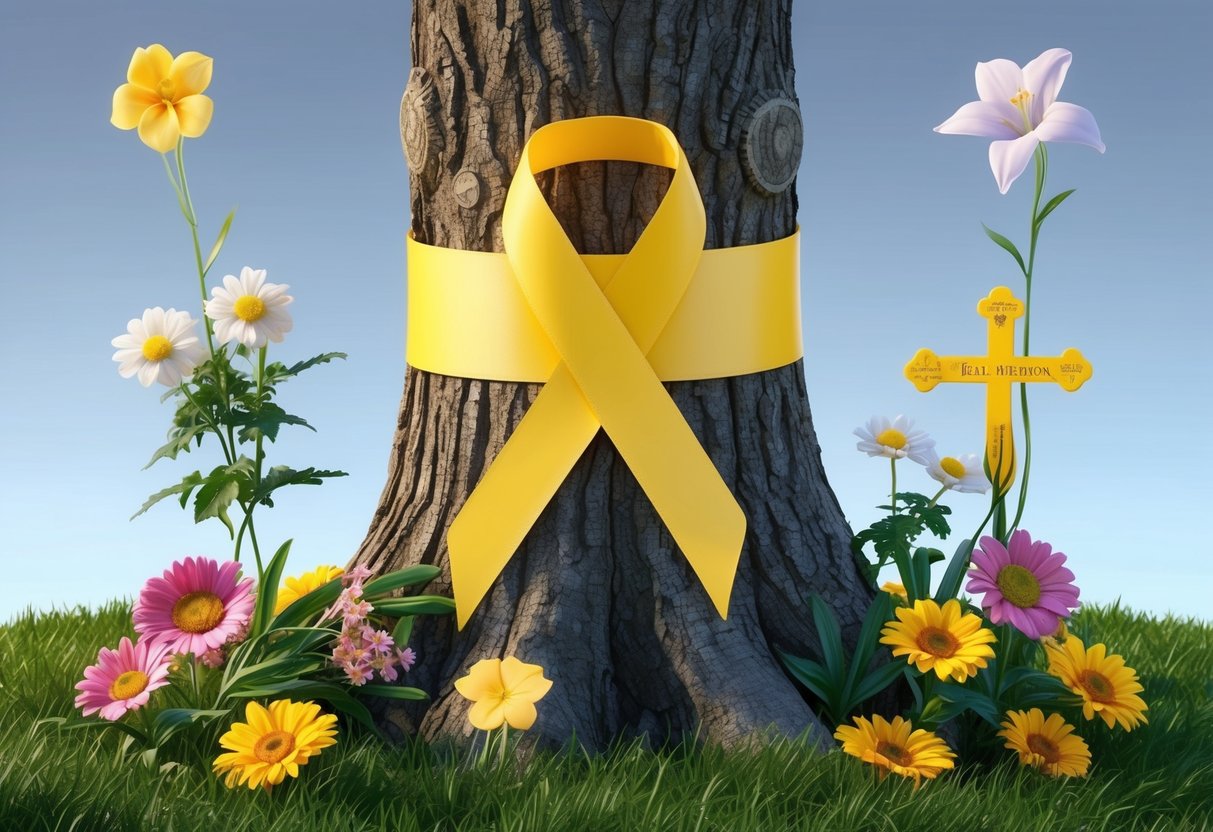When you see a yellow ribbon, you might wonder about its meaning.
The yellow ribbon is a powerful symbol that represents support for various causes, including military troops, missing children, and suicide prevention. Its roots trace back to Puritan times and have evolved through songs, films, and cultural moments, becoming a widely recognized emblem of love and remembrance.
The use of yellow ribbons gained prominence during periods of conflict, most notably during the Iran hostage crisis of the 1970s and later in the Gulf War.
Contents: Yellow Ribbons Explained
It’s a way for people to express their feelings for those who are far away, showing a connection that persists despite physical distance. This depth of meaning makes the yellow ribbon a unique and enduring symbol in society.
Beyond military and remembrance, yellow ribbons are also seen in health awareness campaigns, such as support for those dealing with liver disease. Its versatility in representing different issues is part of what makes the yellow ribbon appealing.
By wearing or displaying a yellow ribbon, you can show solidarity and raise awareness for causes that matter to you.
History and Origin of Yellow Ribbons

Yellow ribbons have served as symbols through different times and cultures. From battlefields to public demonstrations, these ribbons have carried significant messages and meanings.
Ancient Use of Ribbons
Ribbons have been used historically as markers in battles. In the 17th century, soldiers of Oliver Cromwell’s Puritan Army wore yellow sashes or ribbons. These were important for identifying allies on the chaotic battlefield.
The use of ribbons as symbols predates even this period, with colors serving as identifiers in various cultures. In many cases, these were more about practicality and identification rather than carrying symbolic or emotional meanings that we attach to them today.
Modern Resurgence and Popular Culture
In recent history, yellow ribbons reappeared as symbols during times of conflict and national strife.
During the Iran hostage crisis in 1979, Americans used yellow ribbons to show a desire for the safe return of hostages.
This symbolism gained broader fame during the Gulf War in the 1990s. People tied yellow ribbons around trees and homes as a message of hope and support for troops. Popular culture also embraced this, with songs like “Tie a Yellow Ribbon Round the Ole Oak Tree” having influenced public perception and usage.
The ongoing use of yellow ribbons today highlights their continuing role in expressing sentiments of hope, remembrance, and belonging.
Symbols and Meanings Associated with Yellow Ribbons

Yellow ribbons carry a diverse range of meanings. They often symbolize support for various causes and have strong associations with active duty military personnel. Additionally, these ribbons highlight awareness for significant social issues, including health-related and civilian initiatives.
General Representations
Yellow ribbons are widespread symbols representing many causes. Their versatile nature allows them to highlight numerous issues. This adaptability makes them a powerful tool for raising awareness.
In many cases, yellow ribbons serve as a universal symbol of support, uniting individuals across different communities for shared causes. You might see them as symbols of hope, representing various struggles and raising awareness about important societal concerns.
U.S. Military Support and Remembrance
Yellow ribbons are strongly linked to supporting U.S. military troops. They became a symbol to show solidarity with active duty personnel and those returning home. During events like the Gulf War, families displayed them as signs of hope for the soldiers’ safe return.
In remembrance and mourning, yellow ribbons help unite families and communities, expressing a collective desire for peace and resolution. They continue to be a meaningful way to recognize and honor military contributions.
Civilian Causes and Awareness
The yellow ribbon is recognized for shedding light on numerous civilian causes. It plays an important role in campaigns for suicide prevention, liver disease awareness, and missing children initiatives. Its use in these contexts helps generate public interest and support.
By wearing a yellow ribbon, you raise awareness and express concern for these crucial issues. The simple act of displaying this symbol contributes to meaningful conversations and actions in society.
Yellow Ribbon in Health Awareness

The yellow ribbon is widely used to raise awareness for various health causes. It symbolizes support for cancer awareness, mental health, suicide prevention, and other general health conditions.
Cancer Awareness and Support
Yellow ribbons play a significant role in raising awareness for specific types of cancer. Notably, they are associated with bladder cancer awareness. By wearing a yellow ribbon, you can show your support for those affected by this condition and help spread knowledge about prevention and treatment options.
In addition to bladder cancer, yellow ribbons are used to raise awareness for sarcoma and bone cancer. As a symbol, they bring attention to the need for research funding and support services for patients and their families.
Mental Health and Suicide Prevention
Yellow ribbons are crucial in mental health advocacy. They help bring attention to suicide prevention and mental health awareness. By wearing a yellow ribbon, you help combat the stigma surrounding mental health issues and encourage open discussions.
The ribbon serves as a reminder of the importance of mental health support systems. It encourages those who may be struggling to seek help and lets them know they are not alone. Events like World Suicide Prevention Day often use yellow ribbons to highlight the importance of mental health awareness and the need for increased mental health resources.
General Health Conditions
Beyond cancer and mental health, yellow ribbons support awareness for various general health conditions. For instance, they are used to represent endometriosis awareness, a condition affecting many individuals worldwide. The yellow ribbon helps raise visibility and understanding, encouraging better medical research and interpersonal support.
Yellow ribbons can also be part of campaigns to promote general health, wellness, and prevention measures. By participating in these awareness activities, you contribute to a healthier community and foster informed conversations about different health challenges.
Awareness Ribbons and Color Symbolism

Awareness ribbons use colors to represent support for various causes. Different shades signify different issues, creating a globally understood way of expressing solidarity or awareness.
Overview of Awareness Ribbon Colors
Awareness ribbons come in many colors, each symbolizing specific causes. Pink ribbons are commonly associated with breast cancer awareness, while red ribbons often signify support for HIV/AIDS. White ribbons can represent peace, while orange ribbons are used to address hunger and leukemia.
Light blue ribbons often connect to prostate cancer, and dark blue ribbons represent colon cancer awareness. Periwinkle ribbons may symbolize support for stomach cancer and eating disorders. Teal ribbons are associated with ovarian cancer and PTSD awareness.
Specific Colors and Associated Causes
Unlike more common colors, some ribbons carry multiple meanings. Purple ribbons are associated with both domestic violence and pancreatic cancer awareness. Black ribbons are used for mourning or memorials, and sometimes skin cancer. Yellow ribbons can stand for support for troops, missing children, suicide prevention, and other forms of cancer.
Some colors are linked with more than one cause. Green ribbons can represent mental health, cerebral palsy, or environmental concerns. Blue ribbons may symbolize support against child abuse or bullying. Understanding these ribbons helps raise awareness for these significant issues, encouraging advocacy and support.
The Sociopolitical Impact of Yellow Ribbons

Yellow ribbons hold significant social and political power. They are symbols of solidarity and empathy, often showing support for various causes.
Key Causes and Movements:
- Military Support: During the Gulf War in the 1990s, yellow ribbons became widely recognized in America. They showed unity with troops and families awaiting their return.
- Health Awareness: Yellow ribbons are used for awareness of causes like liver disease. They are part of numerous campaigns to educate people on health issues.
- Missing Children: The yellow ribbon has also been used to raise awareness about missing children, bringing communities together to support families and encourage vigilance.
International Contexts:
The Yellow Ribbon Project in some countries focuses on aiding the reintegration of ex-offenders into society. This shows the ribbon’s flexibility in representing reformative justice and community support.
Social Movements:
These ribbons are not just worn—they can be tied around trees and other objects, making them visible symbols in public spaces. They engage communities and spread awareness effectively.
Commemorative and Supportive Functions

The yellow ribbon is a powerful symbol with rich meanings related to support, remembrance, and solidarity. It is often connected to military and veterans, civil rights, and personal and collective mourning.
Military and Veterans
A yellow ribbon is widely known as a symbol of military support. It’s used to show love and hope for soldiers returning home, especially from conflicts or deployments. Tying yellow ribbons on trees has become a heartfelt gesture for families awaiting their loved ones.
This practice gained popularity after the 1970s song “Tie a Yellow Ribbon Round the Ole Oak Tree.” The ribbon represents unity and solidarity with troops serving abroad. It’s frequently used in events and ceremonies to honor veterans and active service members.
Civil Rights and Advocacy
Yellow ribbons also play a role in civil rights movements and advocacy efforts. For instance, in some places, they symbolize calls for democratic change and the release of political prisoners. Such use highlights the ribbon’s ability to convey messages beyond military support.
The Yellow Ribbon Project is one example where the symbol is leveraged for advocacy in promoting second chances. This initiative helps former prisoners reintegrate into society by offering support and breaking down barriers.
Personal and Collective Mourning
In times of mourning, yellow ribbons serve as a visible sign of remembrance and tribute. They are often worn or displayed during memorial events to honor victims of disasters or tragedies. This use showcases the ribbon’s role in personal and collective mourning.
Frequently Asked Questions

Yellow ribbons symbolize a variety of meanings, from military support to medical awareness, and even remembrance. Each context provides a unique insight into how this simple ribbon holds significance.
What significance does a yellow ribbon hold in military contexts?
In military contexts, a yellow ribbon is often used to show support for troops who are away from home. This practice became especially popular during the Gulf War.
Families and communities display yellow ribbons to remind others of the soldiers’ service and their hope for a safe return.
How is a yellow ribbon associated with certain medical conditions?
Yellow ribbons are linked to specific medical conditions, such as supporting awareness for suicide prevention. They are used in campaigns to promote mental health awareness and encourage discussions around seeking help.
This use of the ribbon highlights its role in health advocacy.
Why might someone tie a yellow ribbon on a tree?
Tying a yellow ribbon around a tree signifies waiting for the return of a loved one. This tradition gained broader awareness from the song “Tie a Yellow Ribbon Round the Ole Oak Tree.”
It acts as a hopeful message that the person will return safely.
In what ways does the yellow ribbon serve as a symbol of remembrance or mourning?
Yellow ribbons serve as symbols of remembrance and mourning, especially in tragedies where lives are lost. They were used after events like the MV Sewol ferry disaster in South Korea, representing solidarity and remembrance for those who passed, reinforcing a collective memory.
How is a yellow ribbon used to represent awareness for specific causes?
The yellow ribbon is versatile in representing awareness for various causes, such as supporting troops or raising awareness for illnesses.
It provides a visual cue that informs and mobilizes public support, allowing communities to rally around a shared purpose.
What cultural or historical relevance does a yellow ribbon have?
Historically, the yellow ribbon has roots in songs and campaigns that bolster its cultural relevance. Over time, it evolved to symbolize homecomings. It has been embraced in many cultures as a marker of hope and support for those far away, capturing the public’s emotion and solidarity.



